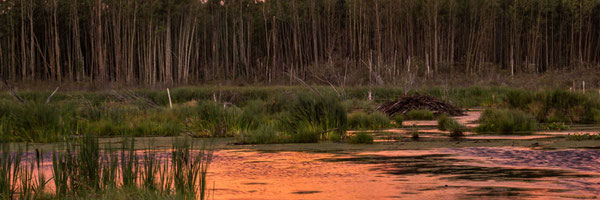Exploring Carbon Sequestration: The Good, the Drawbacks, and the Path Forward
Grade 10
Presentation
Problem
PROBLEM
In our current world, climate change is an area of great concern and has been for the last few decades for good reason. It poses a significant threat to our future on our planet and it has already given us a taste of the implications of our actions as human beings. Burning fossil fuels, deforestation, greenhouse gas emissions - the causes are endless and severe. However, there have been countless methods conceived to counter the effects of the shifting climate, but there is one that emerged somewhat recently and which I will be discussing in this project.
Carbon sequestration is the act of capturing carbon dioxide from the atmosphere and storing it. The process has had a lot of controversy and discussion surrounding it, however I believe that if we can find effective solutions and can catapult it to a global scale, then it could - inch by inch - be possible to reach our goal for net zero emissions.
However, one of the major problems surrounding the process is the cost. Which is one of the things hindering it from being used to its full potential. This is why I will be crafting and developing a theoretical model which could be used as a framework to the solution of the cost issue so that carbon sequestration can be used effectively in the future.
Method
METHOD
Researching the Process:
Researching the background of carbon sequestration serves as a foundation for the understanding of the basic principles and elements of design that are incorporated into this process which will help in the making of the model.
- Looking into the origins of the process. Who had a vision for this? How did it develop? What was the first initiative?
- Delving into the types of processes that it entails, which are: biological, geological, and technological.
Assessing the Issue:
After significant comprehension, there will be analysis and the gathering of data on how to solve the main problem which I’m solving - the cost.
- Having an interview with University of Calgary Professors to understand: Which process is the best at storing carbon? What are the other faults with the process? Has it made a major impact? How can we fix these problems so that there can be effective use in the future?
- Looking at the different types of processes and their statistical graphs to understand which processes we might want to move forward with and emphasize in the future. Looking at the ways we can bring down the costs and how we can use the stored carbon so there is a renewable aspect to the process.
- This will all contribute to the development of the theoretical framework or model which incorporates those ideas and acts as a solution to the problem.
Primary Objective: To develop a theoretical framework that acts as a solution to the major issue of carbon sequestration - the cost. However, incorporating not only the ways to reduce the cost, but also highlighting the renewable properties and the environments for the capture tactics that should be considered.
Secondary Objective: Understanding the origins and history of carbon sequestration. How did it incorporate all of its components? And an inquiry into the depth and breadth of the topic and examining the fine details that go into the making of the process.
Identifying the Variables:
Manipulated: Type of sequestration process.
Responding: How feasible it is to implement and the overall effectiveness.
Thesis: This project aims to develop an effective solution to the cost issue of carbon sequestration. Through an innovative, yet theoretical approach which can possibly reduce the time in achieving net zero emissions. If we work together and take the necessary steps then it could be doable because carbon sequestration can be a powerful tool in the fight against climate change, if used right.
Research
HISTORY OF CARBON SEQUESTRATION:
The conceptualization and practices of carbon sequestering is relatively new. Although the ideas of 'capturing' carbon have been around since the early 20th century, the idea of the 'storing' part wasn't combined with it until very recently. To understand the origin, we have to examine the 'ancestors' if you will.
In the 1920's, a piece of equipment was already being used for carbon capture. CO2 scrubbers. They were cylindrical apparatus that took out impurities from methane. The impurities consisted of carbon dioxide, nitrogen, hydrogen, and a plethora of others. The impurities simply meant that there were other traces of substances and elements instead of the pure methane. To this day, CO2 scrubbers are still being used, and ion exchange resins are one of the new features of the modern carbon dioxide scrubber that are still being explored. Essentially, the scrubber would absorb the carbon dioxide as it is pumped into the device and then the compound would reach an ion exchange resin, which is a polymer that interchanges specific ions within the polymer that is consisted of ions of the other compound (carbon dioxide) that was being transferred through it. Then the carbon dioxide would be discarded.
Enhanced oil recovery is going to be discussed next. It was also a crucial aspect in the origin of carbon sequestration. Carbon dioxide would be injected into fields of oil, which increased the pressure of the reservoir and assisted in the extraction of crude oil, a significant necessity. The implementations of the recovery process made the rounds which led scientists to explore the possibilities of carbon capture and if they could store them underground to mitigate atmospheric pollution.
One scientist in particular, Cesare Marchetti, was rather interested in the process as he recognized that CO2 levels were rising due to fossil fuels, which were becoming prevalent around the late 50's and into the 60's. Marchetti published his paper on his feelings and ideas about the process in the late 70's. Because of this paper, he is widely regarded as one of the most influential scientists for the development of carbon capture and storage. In his paper, he proposed that natural gas processing technologies could be refurbished to capture carbon dioxide and then inject it into the deep ocean where it would stay for thousands of years as a carbon store - another example of the first conceptualizations of carbon sequestration (particularly geological sequestration). In his paper, he states "Fossil energy leads to the release of very large amounts of CO2 into the atmosphere which due to sluggy kinetics takes a very long time until they are eventually digested into the final sink of the deep ocean. As a consequence, CO2 accumulates in the atmosphere, and by altering the infrared diffusion it may provoke important changes in the earth's climatic and rain patterns." We can see how tension regarding the earth's atmosphere was already brewing in the 70's. Little did they know that it would become so much bigger and Marchetti was clever to give a little nudge into the development of carbon manipulation practices. Going back to his ocean injection concept, Marchetti theoreticized that the CO2 would be disposed of into the deep thermohaline currents that carry and spread the CO2 across the ocean which has a large equilibrium capacity. He also added in his abstract that the Mediterranean undercurrent entering the Atlantic at Gibraltar was indentified as one such place to inject the CO2. He stated that it would have enough capacity to store all of Europe's carbon dioxide emissions by the year 2100. He described his whole process as a CO2 "management system." Where the carbon would be collected at certain transformation points and would then be injected into the thermohaline currents.
Eventually, due to other factors, the world's first industrial-scale carbon capture and storage project, which started in 1996, was implemented - the Sleipner Project. The project was conceived to develop a solution to the gas fields in the North Sea which contained high amounts of CO2 that needed to be reduced. It paved the path for more applications of carbon capture and helped encourage trust and attention in the process.
This is just a small portion of the history of the development of carbon sequestration, but it is crucial for our understanding of the process and how it has evolved to become the thing it is today.
TYPES OF PROCESSES FOR CARBON SEQUESTRATION:
BIOLOGICAL
The biological process of carbon sequestration is the act of carbon dioxide being stored in living things and ecosystems. For example, plants, trees, forests, oceans, etc;
OCEANIC CARBON SEQUESTRATION
According to the University of California, Davis, oceans take in roughly 25% of the carbon dioxide held in the troposhere. The carbon is 'exchanged' which means that the ocean absorbs the compound but it also exits. It creates what is in my mind, a reciprocal loop, because the the carbon goes both directions. Into the ocean and out of the ocean. Positive atmospheric flux is the term used to describe the process of carbon dioxide exiting the ocean (due to the high temperatures and oceanic currents), while negative atmospheric flux is the term used to describe the process of carbon dioxide entering the ocean. Ergo, the equilibrium created is what defines the overall effect of the carbon removed. As I mentioned above, due to the patterns in the ocean and the high temperatures it gives off, carbon is more efficiently absorbed in the colder parts of our planet's ocean body. Adding to the idea of carbon storage, this is why oceans are carbon sinks, and we can see this because of the dinosaur fossils present in the ocean. The bones are likely storing a lot of carbon dioxide which makes the ocean a host for a galore of CO2, and by connecting the concepts we can see why the burning of fossil fuels contributes to climate change. However, this abundance of CO2 in the ocean is regarded as a growing problem, and at this rate by 2100, the CO2 present in the ocean might significantly modify the ocean's chemical properties, thus leading to a more acidic environment which could pose as a threat for aquatic ecosystems.
CARBON SEQUESTRATION IN SOIL
Thanks to the process of photosynthesis in plants, heaps of carbon are stored in our earth's soil environments today. The stored organic carbon is sometimes known as soil organic carbon or SOC. However, agricultural practices can disrupt the carbon, causing levels to drop significantly. But, this opens the door for innovative land management practices. Carbonates (a form of carbon) can also be stored in the soil. They are generated over the course of thousands of years due to carbon dioxide dissolving in water and percolating the soil, which joins hands with calcium and magnesium minerals, forming a substance called 'caliche' in the soil of arid landscapes and deserts.
CARBON SEQUESTRATION THROUGH FORESTS:
As mentioned above, photosynthesis is the process by which a plant is able to absorb carbon dioxide. Tiny pores on the underside of the leaf - called the stomata - open when the water inside the guard cell of the plant expands and makes the cell flaccid. This allows for carbon dioxide to enter. This carbon dioxide is then transferred to the soil. One area of issue however is the wildfires and the deforestation that is happening at an alarming rate. Since these trees are carbon sinks, when they burn or are chopped down, they release carbon dioxide, which adds more volume of CO2 into the troposphere. The preservation of these lands could significantly increase the amount of carbon dioxide intake. Grasslands and wetlands have a much heavier concentration for carbon storage, with coastal wetlands storing more carbon per hectare than other environments and habitats like forests.
GEOLOGICAL
It is the process of storing carbon in the rocks and underground geological formations. Carbon would be captured from an industrial source - one which produces energy (like power plants or natural gas processing facilities) - and would be injected into feasible (porous) rock formations that would theoretically hold the carbon for a great amount of time.
The carbon dioxide is usually pressurized into a liquid substance before being injected into the formations. The geologic aspect of sequestration is also part of something which I discussed in the history - enhanced oil recovery. For the sole purpose that this tertiary recovery would allow for the production of good oil in the future.
One essential rule for this sub process is that the layer of rock must be covered by another layer of impermeable (nothing can exit or enter) rock so that the carbon dioxide is sealed.
Typically the following geological characteristics are accounted for:
- Rock formations have sufficient millimetre-sized voids/pores to have the ability to store the carbon dioxide.
- Pores in the rock should be able to connect to one another, which is a feature called permeability. This is to make up for the amount of CO2 at the rate that it's injected, which allows for the compound to move more freely within the formation.
So, which formations are suitable for this process?
1. Oil and gas reservoirs
2. Deep saline formations
3. Unminable coal seems
A study by the USGS depicted that the Coastal Plains region (which spans from Texas to Georgia) would have the most geological storage potential for CO2 and as well as the Rocky Mountains and Alaska.
Some more formations:
- Salt caverns
- Basalt formations
- Sedimentary rocks mostly
TECHNOLOGICAL:
It is the process which uses a variety of technological methods to store the captured carbon dioxide.
GRAPHENE PRODUCTION:
The use of carbon dioxide to create a raw material - graphene. This showcases the renewable effects of CO2. Graphene is used to create screens for smartphones and other technological devices. This shows how carbon capture is a solution but also a resource for the production of important resources.
DIRECT AIR CAPTURE:
Directly capturing carbon from the troposphere using artificial plants. However, this process is not cheap and requires lots of energy, ranging from $500-800 per ton of carbon removed. While they can be effective, it's too costly to be used at a wider scale at this moment in time.
ENGINEERED MOLECULES & IONIC LIQUIDS:
Scientists are engineering molecules that can manipulate their shape by creating new kinds of compounds capable of suspending out and capturing the desired carbon dioxide from the air. The engineered molecules mere act as a filter, only attracting the element (carbon dioxide) it was tasked to seek.
Two dimensional ionic liquids have a molecular structure that allow for higher rates of CO2 to be absorbed due to their 'ultralow vapor pressure.' This is a considered an environmentally friendly alternative.
GIANT AIR FILTERS:
In China, companies have created experimental commercial air filtration systems, massive towers that clean air of pollutants on a wide scale. This is done by the air being drawn into glass rooms, which are then heated using solar power which creates a greenhouse effect. The hot air is then pushed up through the tower through a series of filters, before being released back into the atmosphere as clean air.
PROFESSOR INTERVIEW: On Carbon Sequestration's Role In Our Future with Mr. Benjamin Tutolo and Mr. Justin Ezekiel.
Note: The following interview has not been recorded in full. Hence, it has been paraphrased in bullet points.
Q1 "Which process of carbon sequestration do you think is the most effective? Why?":
Mr. Tutolo:
- Plant more trees. Trees are great. But, trees can also burn down.
- Not necessarily great.
- Some processes where we use ethanol to power something (more stability).
- Prevent CO2 combustion through capture processes.
- Now looking at processes like direct air capture (part of Mr. Tutolo's research).
Mr. Ezekiel:
- There is a huge volume of CO2.
- For that reason, geological and technological work best.
- Huge space on the ocean surface.
- Biological works simply.
Q2 "Do you think sequestration has effectively been able to mitigate climate change? What are the faults? What is your stance?":
Mr. Tutolo:
- It does work.
- However, not been implemented to efficiently stop climate change.
- Upscaling is needed.
- There are only a handful of projects. Quest Project and Aquastore project.
- Not significant yet in the drive towards net zero.
Mr. Ezekiel:
- Capital is the issue.
- Not cheap tech advancement.
- Geological formation drilling and other processes are not cheap.
- Without incentives not viable.
- Enable more participation.
Q3 "So, I'm focusing more on the cost but how do you think we can fix those problems like cost or energy use or those problems so it [carbon sequestration] can be used effectively in the future?":
Mr. Tutolo:
- Getting a little cheaper.
- But still costs more.
- There is not enough awareness. Not well considered.
- CO2 is toxic, harmful waste.
- Analogy: Poop is immediately distasteful but CO2 comes gradually.
Mr. Ezekiel:
- Public involvement.
- Government involvement.
- Awareness overall.
- How it could affect investments.
- More floods.
- Giving a run down of the risks.
- We keep emitting CO2.
- Invest in renewable energy, so less is going out.
- Reduce dependence on CO2.
- Not going to go away quickly, takes some time.
- Utilize CO2 (part of Mr. Ezekiel's research).
- CCUS
- Can be recycled.
- Heating and cooling.
- Power generation.
- Economics
- Making revenue
- It needs development in our drive towards net zero.
THE CARBON HOME MODEL:
After researching, analyzing, and gathering data, it all culminates in the creation of my model - the Carbon Home Model. A theoretical framework that could act as a solution for the problem which I’m solving - the cost - while also showcasing environments which would be the best at absorption and the ways we can reuse the carbon dioxide.
After the analysis of the data, research, and interview with the professors, I have come to the conclusion that the biological process - even though it works quite simply - is the best solution/process to carbon sequestration. You don’t need money for plants to acquire carbon or oceans for that matter - it is a natural phenomenon, and is the path we should take forward for the future.
Most of the technological advances in sequestration are still under development and are quite costly. The same can be said for the geological process, where this cost issue really lies. The drilling and injection of CO2 is not at all cheap, and the selectivity of the rock formations requires time and effort. Hence, the biological process is our best shot if cost is the barrier in front of the success of a global and effective use of carbon sequestration.
COMPONENT I - THE HOME
So, the biological process is the most substantial, but let’s get more specific, because in the data that I have found, it has been observed that the wetland ecosystem harbors the most carbon dioxide absorbed out of any other vegetation. Fortunately for us in Alberta, we are home to approximately 21.7% of wetland areas. Fen is the most common type of wetland, while the water, swamp, bog, and marsh types follow. This is the foundation of my model. I strongly believe that if we can create designated areas of wetlands strictly used for carbon sequestration, then Alberta will be significantly helping in the drive towards net zero emissions at a slow but steady rate. Now you may be asking, but shouldn’t this already be happening? That the wetlands must already be sequestering the carbon dioxide? Well, you are right, but the wetland environments in Alberta are currently under significant threat. They have been suffering loss through degradation and alterations due to human activites such as: agriculture and urban expansion, forestry, oil and gas development, mining, agricultural practices, population growth, and numerous others. However, Alberta has implemented the Alberta Wetland Policy which aims to minimize the degradation and loss of the wetlands but has not gotten that much praise. Critics of the policy state that it doesn't actually provide protection and lacks proper communication which doesn't contribute to its overall effectiveness. This is where my other component comes into play and addresses the cost issue and this flaw as well.
COMPONENT II - THE PRECIPITATION
I have used the analogy of precipitation for this next component. Because it is in my mind the liquid that facilitates the expansion of this model. First of all, government incentives. As Mr. Ezekiel explained in the interview, there has to be more cooperation between all of us and with these government incentives for the development of these protected wetland areas, it will definitely feel like it. This is also one of my solutions to the cost issue of carbon sequestration, because government-funded initiatives will have more stability in the long-run. We can get government incentives through the next subcomponent. Public awareness and support. If we don’t tell the public what will happen if there are more emissions of CO2, then we will be in a limbo. Floods, higher temperatures - we should not be using this as a fear factor but as an awareness one. They need to know the potential - and which are slowly coming to fruition - risks associated with these high levels of carbon dioxide in the troposphere. If we get public support and awareness then this could translate into the mentioned incentives. And if we’re being ambitious, we can even try to set up organizations led by people who can raise money for the installations of these wetland projects across not only Alberta - but across the country since every province and territory has some form of wetland environment. This is my second solution to the cost issue.
COMPONENT III - THE MONITORING (FOR THE FUTURE)
As I was thinking about how this model would work, I thought to myself about what we could do with the carbon dioxide that was harvested from the wetland’s instead of keeping it stored there. So that there could be an actual use of that carbon dioxide as we have seen with the graphene production and the other renewable processes. This is so that we’re not just storing the carbon, but finding ways to reuse it. We brought it out so we should bring it back in. This component doesn’t have to be implemented since monitoring takes a lot of time and people which will make the model more expensive. However, I looked at techniques which monitor the carbon dioxide and found a technique specifically for wetlands where peat cores are taken from samples from the soil of the wetland, which then go to a laboratory that determines the volume of carbon dioxide. It is then combined with the knowledge of the area of the wetland to which assumptions are made of the overall carbon dioxide content. Some other methods were making connections between meteorological factors like evaporation and transpiration so there could be an estimation of carbon dioxide in the environment. Keeping these techniques in mind, we can start thinking about how we can get the carbon out.
COMPONENT IV - THE EXTRACTION (FOR THE FUTURE)
Eventually, if we’re being even more ambitious than we already are, then extracting the carbon dioxide would be the last step. If we remove the carbon from the wetlands then we could look into potential uses such as electricity production, heating, cooling, graphene production, etc; One removal process that has been used in forests is BECCS or Biomass Energy with Carbon Capture and Storage. This is where the biomass filled with carbon dioxide (forests and grases) are burned in order to produce electricity. However, I would take inspiration from this and not actually implement this because it would be completely hypocritical of our model. That’s why this last component is something that is definitely an area for development but something we should strive towards.
FINAL NOTE: Taking all of these components of the Carbon Home Model into mind, the last two are even more hypothetical and theoretical than this model already is. For now, the first two are what will create a good foundation for this solution to the cost issue and will provide an efficient process of sequestration. Even with just them, we are significantly reducing the time needed for net zero emissions.
Data
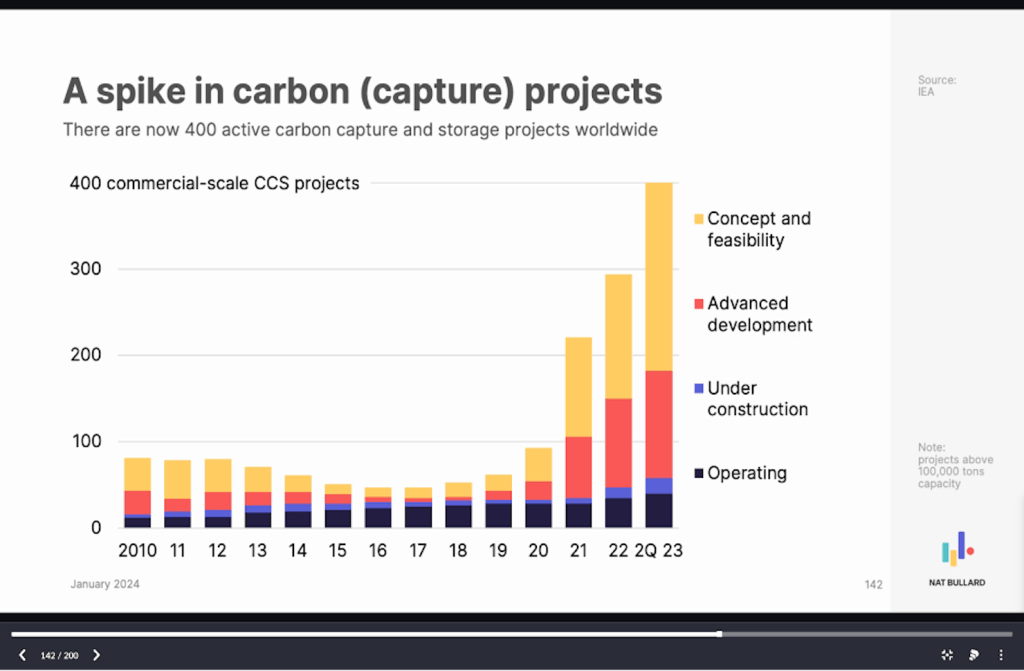
Figure #1:
We can conclude from this graph that there is a growing interest in carbon capture projects but very few are in operation, which could be telling of the problems of the process which hinders further operations.
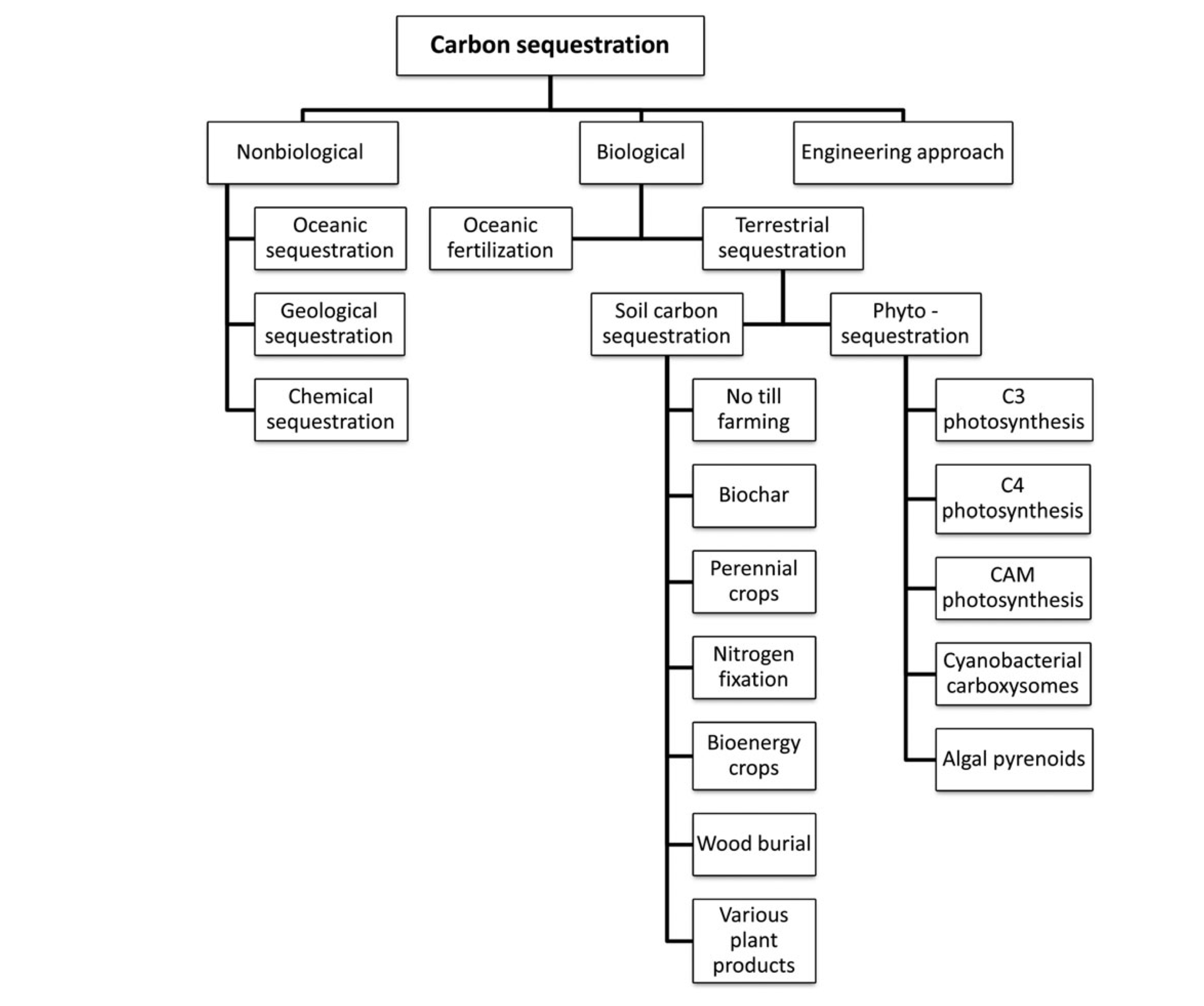
Figure #2:
Gives us a look at the breadth of the types of carbon sequestration.
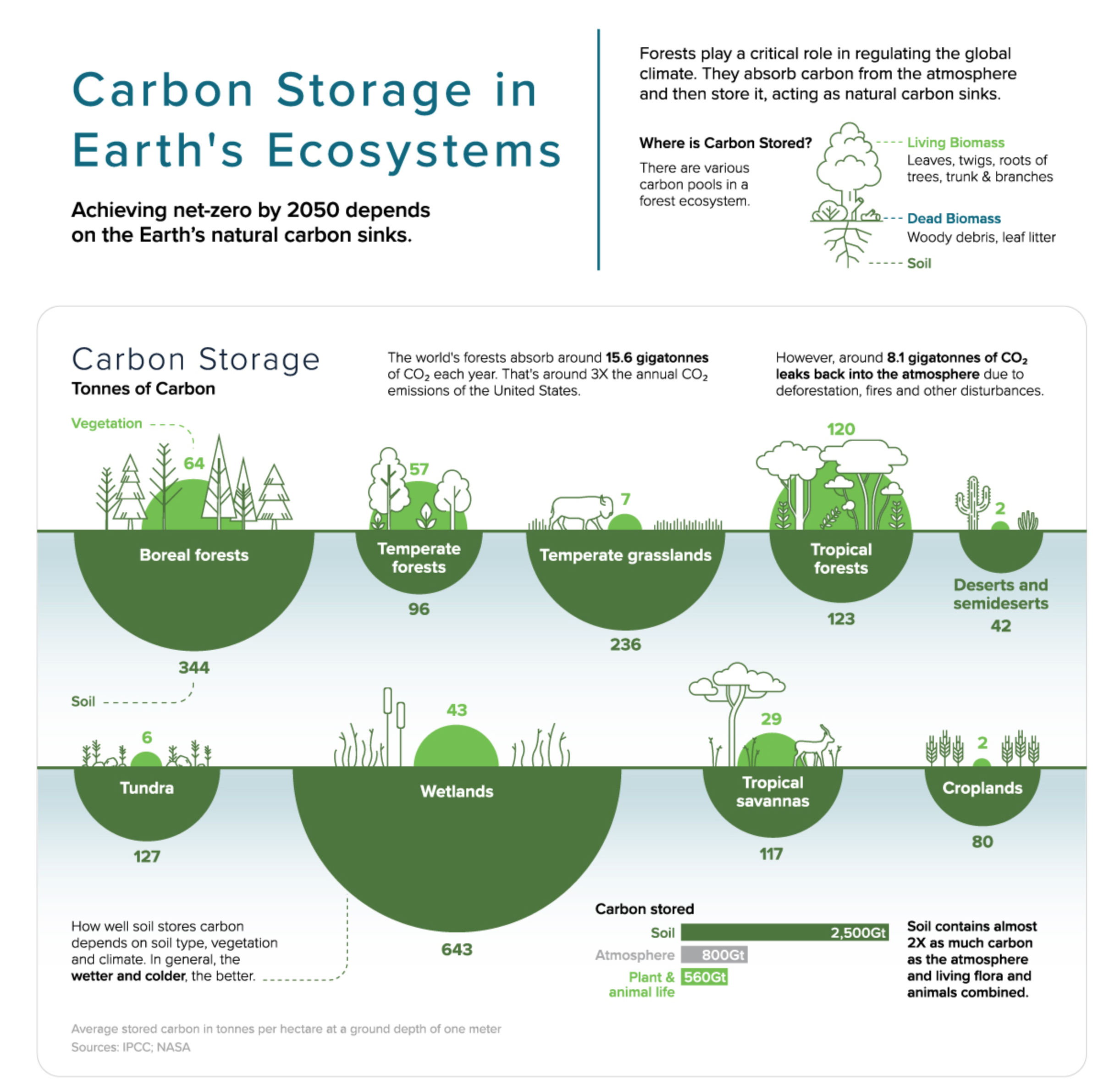
Figure #3:
We can conclude from this visual that the wetland environment has the most carbon dioxide absorption out of any other environment.
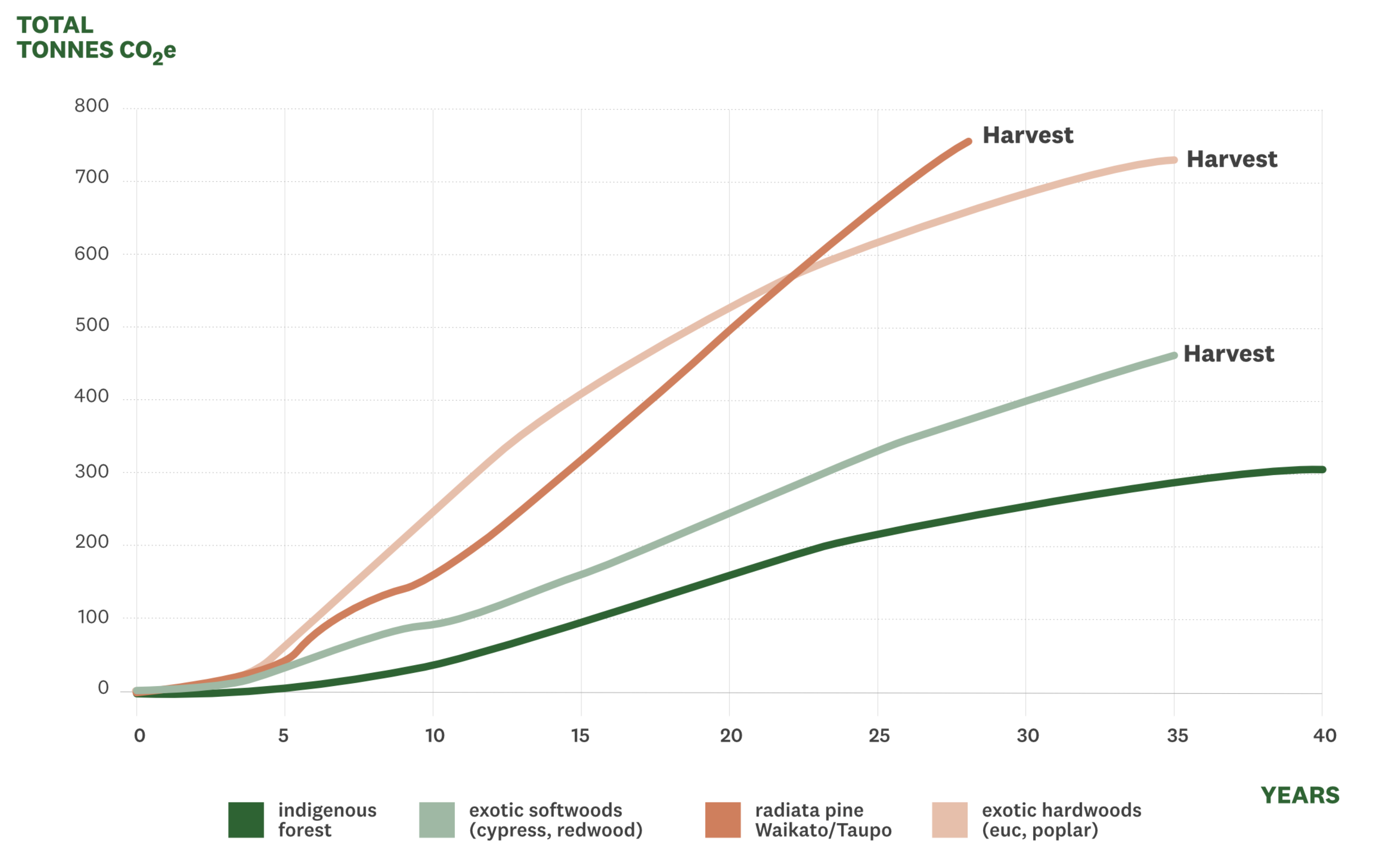
Figure #4:
An interesting look at different types of trees and the amount of carbon dioxide they sequester.
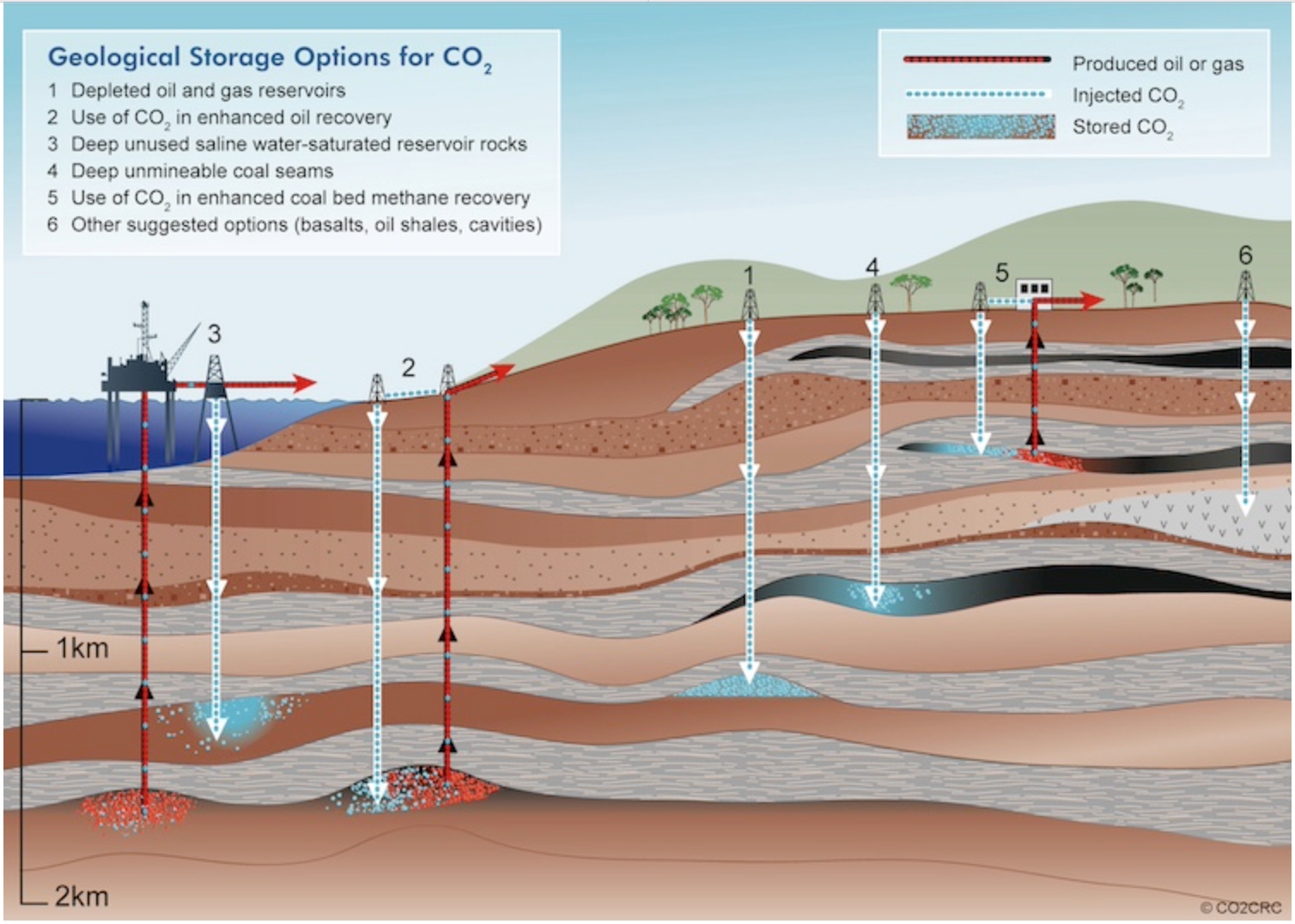
Figure #5:
A visualization of the process of geologic carbon sequestration and the setting where the sequestration happens.
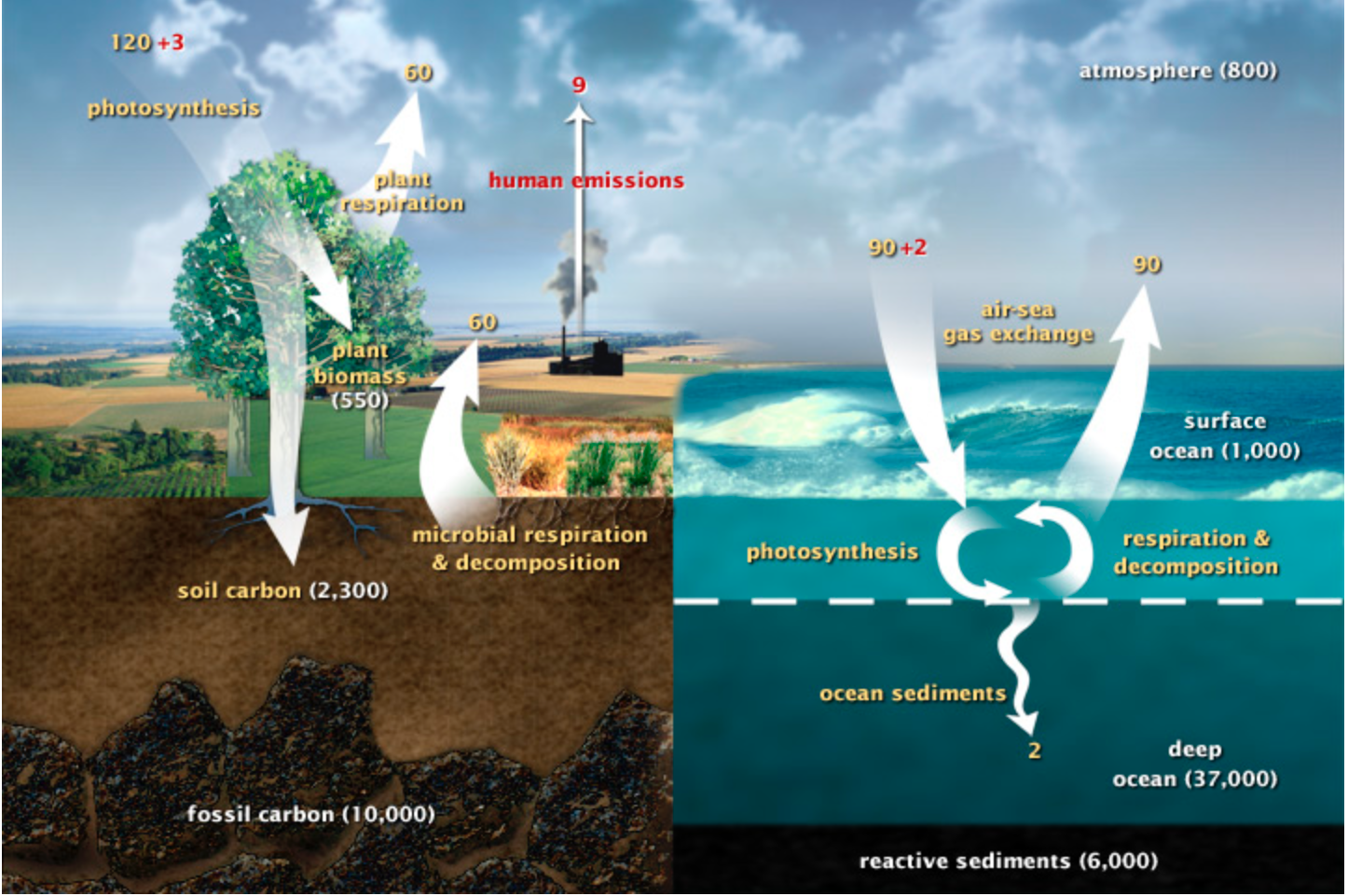
Figure #6:
A depiction of the cycle of carbon dioxide in trees, soil, and aquatic environments.
The following three graphs are part of a study which collected peat cores from the soil's of wetlands to measure carbon dioxide levels in wetland ecosystems. They also collected tree samples and shrub samples as well.
Graph 1/3
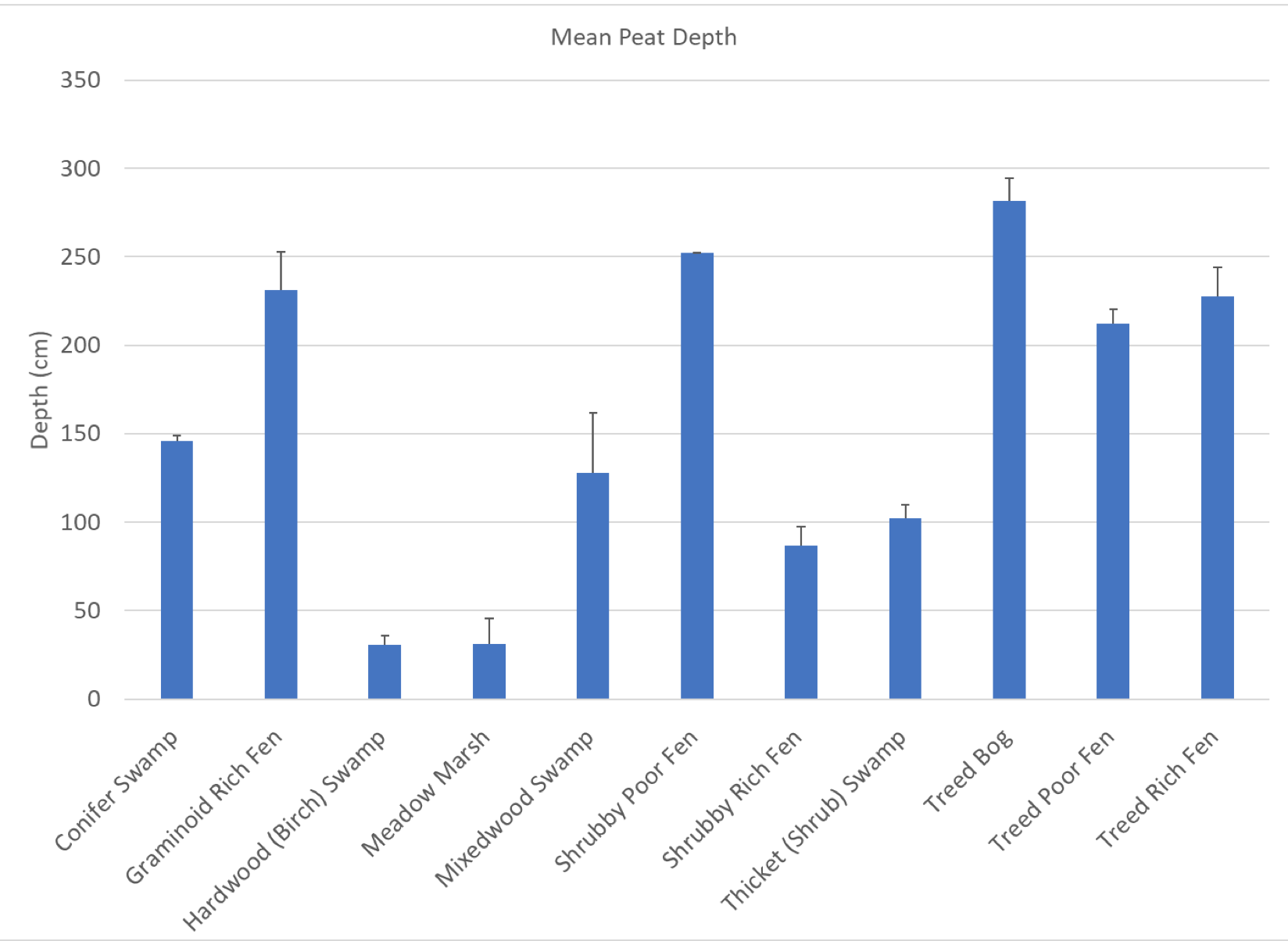
Figure #7:
We can see from the graph that the treed bog's peat cores were at a greater average depth than the other fens, swamps, and marshes.
Graph 2/3
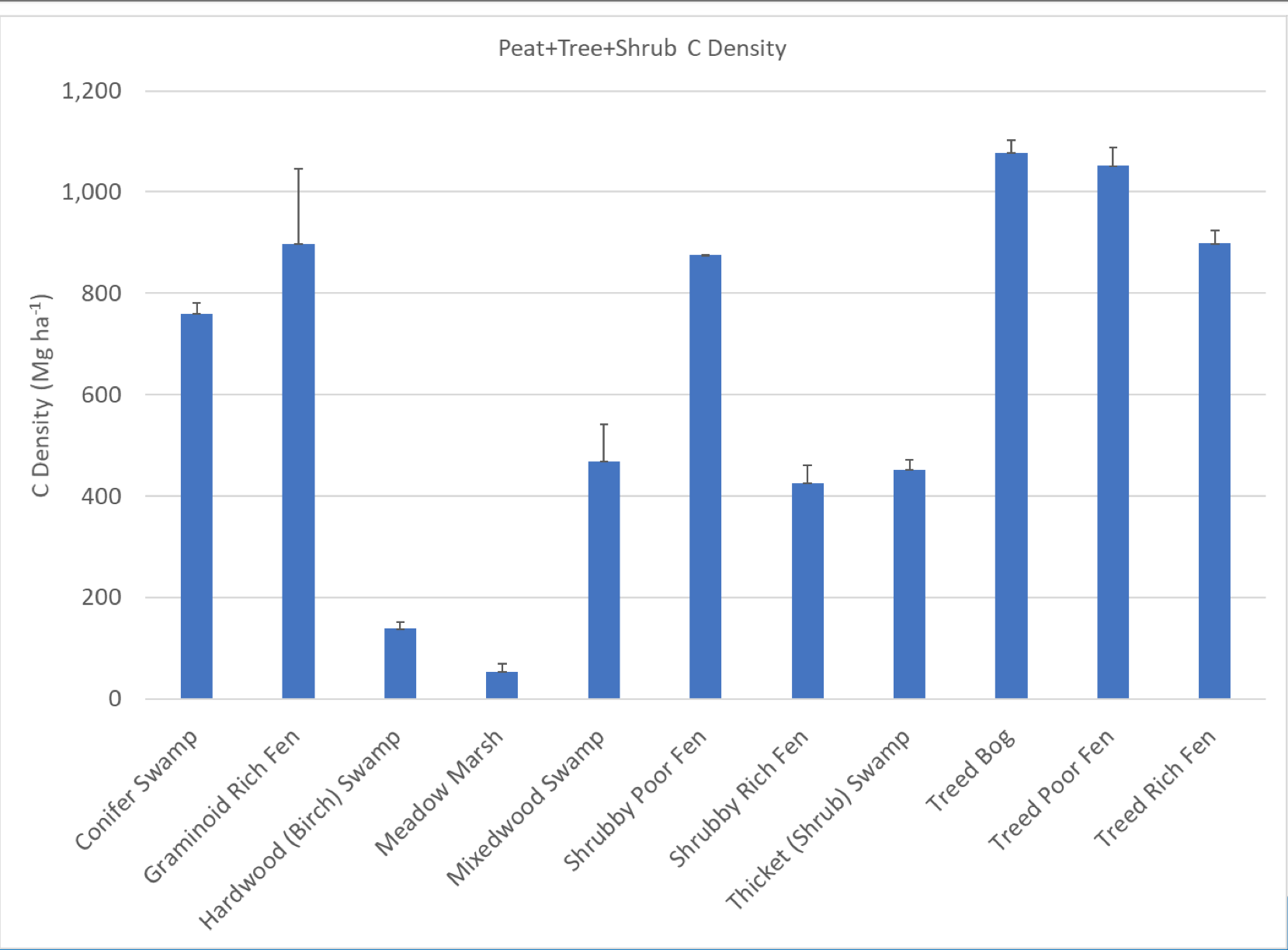
Figure #8:
From this graph, we can analyze and interpret to conclude that the treed bog had the highest carbon dioxide density combining factors like peat's, tree's, and shrubs.
Graph 3/3
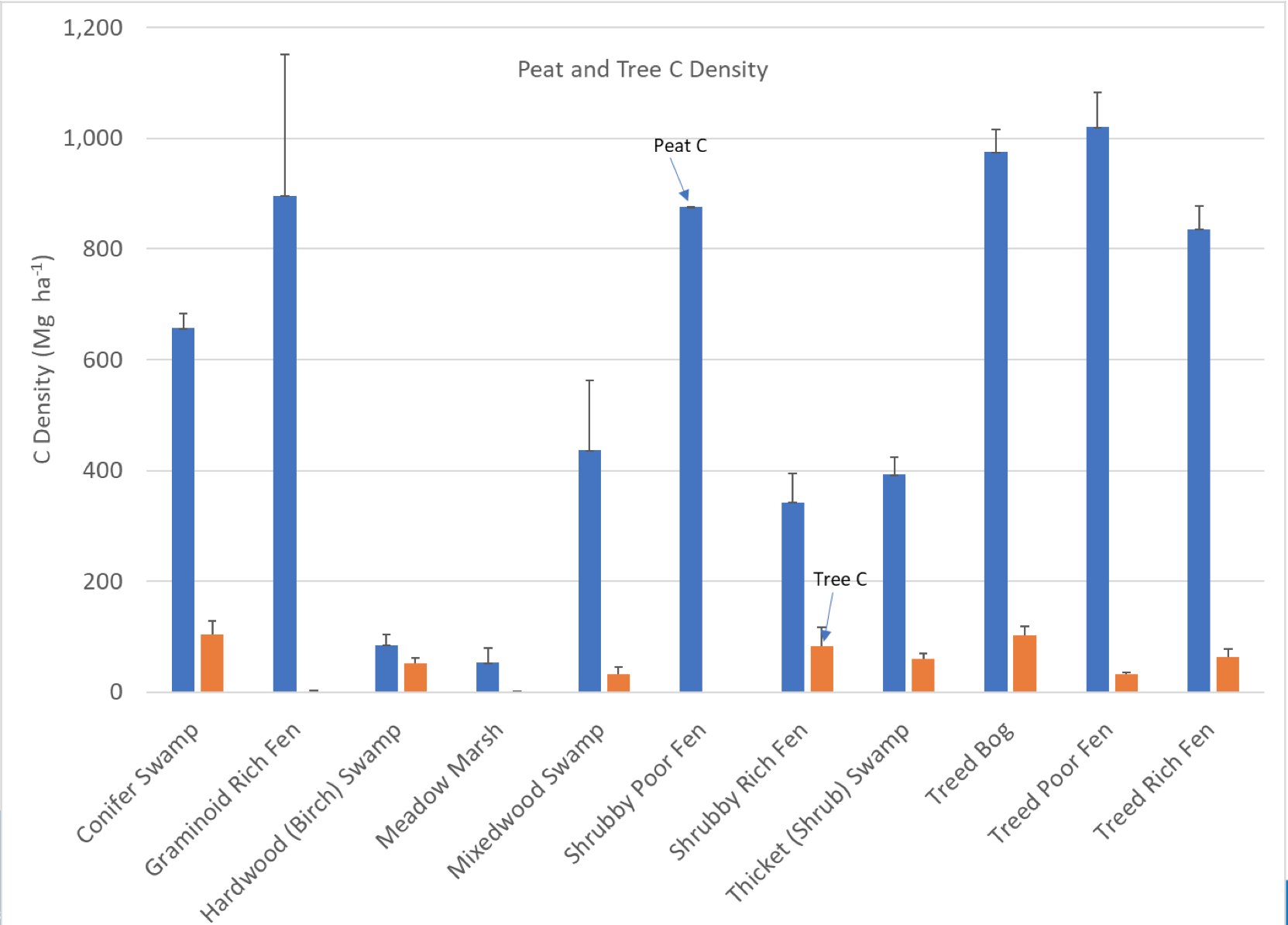
Figure #9:
We get a detailed look at the different tree's carbon dioxide density from the different environments which is indicated in orange. And when it is added up that's what makes graph 2.

Figure #10:
An illustration of my Carbon Home Model. Illustrations were done by Rayan Isaac.
Conclusion
CONCLUSION:
Carbon sequestration. The process of capturing carbon from the atmosphere and storing it. Looking at the history of this process, it has definitely come a long way, from its early hints in the CO2 scrubbers to the first commercial-scale project. My aim for this project was to find a solution to the cost issue of the process. And in doing that, I was also able to conclude which environments would be the most logical for efficient sequestration of CO2, and assessing ways for monitoring and potential reusage. This led to the creation of my theoretical framework, the Carbon Home Model. The Carbon Home Model is a fully theoretical solution (but can be made to fruition) that has components which work together to create an efficient and effective sequestration process of carbon dioxide. The 'home' is the wetland environments that the carbon will be absorbed by specifically. This was the environment that I concluded was the most logical for efficient sequestration, due to data analysis and research on its sequestration ability. Government incentives and public awareness and funding will be able to support the protection of these specific wetland sequestration areas which fortunately for us in Alberta - there are a lot of them (and in Canada as a whole).
This is also the solution to the cost problem. Because by a collective funding of money, the process will become cheap, and that is why this model makes sense and addresses all aspects so that there is efficient and effective use without needing heaps of money. Looking at the way the technological and geological processes are done, its fine, but its too time-consuming and expensive. Why not make use of the natural vacuums we have at our disposal? They are the heros who can help us. But, we also have to keep in mind that we have to raise awareness so that there is more funding and government support, because if the people don't know the risks, then they won't feel the need to care for initiatives like these.
Consequently, the Carbon Home Model is my innovative approach to a formidable problem in the carbon sequestration world. It is unique in the way it is setup with the requirement of all components working together in harmony and cooperation, to achieve one specific goal - mitigating climate change. If we can propose more models like these and implement them then we can create a world-wide success. Where everyone is actively participating in their specific ways of mitigating climate change. But most importantly, where we are all working together as one whole, to fight for our home.
AREAS FOR IMPROVEMENT:
Some areas for improvement in the context of carbon sequestration would be finding solutions to its other problems, such as energy use and leakage. Additionally, developing methods in the future to monitor the carbon dioxide in the context of my model and finding smart ways to extract the CO2 without damaging the wetland environments for reusage.
Citations
References:
Marsh, Jane. "History and Pitfalls of Carbon Sequestration." Renewable Energy Magazine. June 29, 2022. https://www.renewableenergymagazine.com/jane-marsh/history-and-pitfalls-of-carbon-sequestration-20220629#:~:text=Scientists%20first%20proposed%20a%20carbon,together%20in%20Norway%20in%201996.
Morin, Andre. "Is Carbon Capture Accelerating Global Warming?" syn-op-sis. November 26, 2021. https://synopsis.mcmaster.ca/?p=87176
Marchetti, Cesare. "ON GEOENGINEERING AND THE CO2 PROBLEM." International Institute for Applied Systems Analysis. March, 1976. https://pure.iiasa.ac.at/id/eprint/667/1/RM-76-017.pdf
Iltaf Hasnain, Khawaja. "Carbon Capture and Storage: The Past, Present, and Future." The Way Ahead. July 11, 2024. https://jpt.spe.org/twa/carbon-capture-and-storage-the-past-present-and-future
Ma, Jinfeng - Li, Lin - Wang, Haofan - Du, Yi - Ma, Junjie - Zhang, Xiaoli - Wang, Zhenliang. "Carbon Capture and Storage: History and the Road Ahead." ScienceDirect. March 12, 2022. https://www.sciencedirect.com/science/article/pii/S2095809922001357
"A brief history of climate change discoveries." UK Research and Innovation. https://www.discover.ukri.org/a-brief-history-of-climate-change-discoveries/index.html
"How Do CO2 Scrubbers Work?" Atlas Scientific. November 4, 2022. https://atlas-scientific.com/blog/how-do-co2-scrubbers-work/#:~:text=Air%20polluted%20with%20CO2%20is,either%20be%20discarded%20or%20reused.
"ION EXCHANGE RESINS." University of California, Irvine. https://www.chem.uci.edu/~unicorn/M3LC/handouts/AdditionalNotes/ionexchangeresins.pdf
Skalmeraas, Olav. "Sleipner carbon capture and storage project." Institution of Civil Engineers. February 3, 2017. https://www.ice.org.uk/areas-of-interest/energy/sleipner-carbon-capture-and-storage-project#:~:text=The%20Sleipner%20CCS%20project%20offshore,of%20a%20gas%20field%20development
Santese, Tiziano - Shvab, Jaroslaw - Suslov, Dmitry - Haidn J., Oskar - Slavinskaya, Nadezda. "Impact of impurities on liquid methane properties under typical rocket operation conditions." ScienceDirect. March 29, 2023. https://www.sciencedirect.com/science/article/pii/S2666202723000629#:~:text=The%20methane%20impurities%20present%20in,substances%20are%20visualized%20in%20Fig
Alkhatib I.I., Ismail - Llovell, Felix - Vega F., Lourdes. "Assessing the effect of impurities on the thermophysical properties of methane-based energy systems using polar soft - SAFT." ScienceDirect. September 29, 2020. https://www.sciencedirect.com/science/article/abs/pii/S0378381220303897#:~:text=Polar%20soft%2DSAFT%20has%20been,their%20binary%20mixtures%20with%20methane
"What is Carbon Sequestration and How Does it Work?" CLEAR Center at the University of California, Davis. September 20, 2019. https://clear.ucdavis.edu/explainers/what-carbon-sequestration
"Carbon Capture." Center for Climate and Energy Solutions. https://www.c2es.org/content/carbon-capture/
"What's the difference between geologic and biologic carbon sequestration?" USGS. https://www.usgs.gov/faqs/whats-difference-between-geologic-and-biologic-carbon-sequestration#:~:text=Geologic%20carbon%20sequestration%20is%20the,rock%20formations%20in%20geologic%20basins
"The Concept of Geologic Carbon Sequestration." USGS. https://pubs.usgs.gov/fs/2010/3122/pdf/FS2010-3122.pdf
"Geological Storage of CO2: Safe, Permanent, and Abundant." Global CCS Institute. https://www.globalccsinstitute.com/wp-content/uploads/2018/12/Global-CCS-Institute-Fact-Sheet_Geological-Storage-of-CO2.pdf
"Rock formations suitable for CCS." CO2 Capture Project. https://www.co2captureproject.org/pdfs/rock_formations_suitable_for_ccs.pdf
"Which area is the best for geologic carbon sequestration?" USGS. https://www.usgs.gov/faqs/which-area-best-geologic-carbon-sequestration
"Geological Sequestration." Climate Change Connection. https://climatechangeconnection.org/solutions/carbon-sequestration/geological-sequestration/
"Chapter Seven: Sequestration of Supercritical CO2 in Deep Sedimentary Geological Formations." National Academies Press. https://nap.nationalacademies.org/read/25259/chapter/9
Benson M., Sally - Cole R., David. "CO2 Sequestration in Deep Sedimentary Formations." GEO Arizona. October, 2008. https://www.geo.arizona.edu/~reiners/geos195K/CO2Sequestration_Benson_ELEMENTS.pdf
"Carbon capture technology and how it works." nationalgrid. https://www.nationalgrid.com/stories/energy-explained/carbon-capture-technology-and-how-it-works
Herzog, Howard. "Carbon Capture." MIT Climate Portal. https://climate.mit.edu/explainers/carbon-capture
"What is Biological Carbon Sequestration?" University of California, Davis. https://www.ucdavis.edu/climate/definitions/carbon-sequestration/biological
Riebeek, Holli. "The Ocean's Carbon Balance." Earth Observatory. July 1, 2008. https://earthobservatory.nasa.gov/features/OceanCarbon#:~:text=As%20temperatures%20rise%2C%20carbon%20dioxide,from%20limestone%20and%20other%20rocks
Chinese Academy of Sciences. "Two-dimensional ionic liquids to effectively capture carbon dioxide." Phys.Org. July 12, 2022. https://phys.org/news/2022-07-two-dimensional-ionic-liquids-effectively-capture.html
Morales, Margaret. "The most important decarbonization chart you'll see this year." Trellis. February 8, 2024. https://trellis.net/article/most-important-decarbonization-chart-youll-see-year/
"COLLABORATING FOR A NET-ZERO FUTURE." Global CCS Institute. https://www.globalccsinstitute.com/wp-content/uploads/2024/11/Global-Status-Report-6-November.pdf
Riebeek, Holli - Design by Robert Simmon. "The Carbon Cycle." Earth Observatory. June 16, 2011. https://earthobservatory.nasa.gov/features/CarbonCycle
Nogia, Panchsheela - Sidhu Kaur, Gurpreet - Mehrotra, Rajesh - Mehrotra, Sandhya. "Capturing atmospheric carbon: biological and nonbiological methods." International Journal of Low-Carbon Technologies Advance Access. October 30, 2013. https://www.researchgate.net/profile/Panchsheela-Nogia/publication/273025007_Capturing_atmospheric_carbon_Biological_and_nonbiological_methods/links/5740041a08ae9ace84134be4/Capturing-atmospheric-carbon-Biological-and-nonbiological-methods.pdf?origin=publication_detail&_tp=eyJjb250ZXh0Ijp7ImZpcnN0UGFnZSI6Il9kaXJlY3QiLCJwYWdlIjoicHVibGljYXRpb25Eb3dubG9hZCIsInByZXZpb3VzUGFnZSI6Il9kaXJlY3QifX0
Neufeld, Dorothy - Graphics and Design by Smith, Miranda. "Visualizing Carbon Storage in Earth's Ecosystems." Visual Capitalist. January 22, 2022. https://www.visualcapitalist.com/sp/visualizing-carbon-storage-in-earths-ecosystems/
"Trees and Vegetation." Ag Matters. https://www.agmatters.nz/actions/current-actions/planting-trees/
Wylie, Margie. "Clearer Picture of Carbon Sequestration." NERSC. January 31, 2011. https://www.nersc.gov/news-publications/nersc-news/science-news/2011/clearer-picture-of-carbon-sequestration/
"Wetlands." Alberta.ca. https://www.alberta.ca/wetlands#:~:text=In%20Alberta%2C%20wetlands%20have%20been,and%20gas%20exploration%20and%20development
Safdie, Stephanie. "6 Examples of Carbon Dioxide Removal." Greenly Earth. April 25, 2024. https://greenly.earth/en-us/blog/company-guide/6-examples-of-carbon-dioxide-removal
"Distribution of Wetlands in Alberta." Wetland Atlas of Alberta. https://wetland-report.abmi.ca/atlas-home/2.0-Alberta-Wetlands/2.1-Alberta-Wetland-Inventory.html#:~:text=Highlights%20*%20Wetlands%20cover%2021.7%25%20(143%2C628%20km2),areas%20(33%2C656%20km2%20out%20of%20143%2C628%20km2).
"Wetland Loss." Wetlands Alberta. https://wetlandsalberta.ca/wetland-loss/
"Alberta Wetland Policy implementation." Alberta.ca. https://www.alberta.ca/alberta-wetland-policy-implementation#:~:text=wetlands%20of%20the%20highest%20value,wetland%20management%20considers%20regional%20context
"Alberta's new wetland policy: baby steps in an adult world." Environmental Law Centre. https://elc.ab.ca/post-library/albertas-new-wetland-policy-baby-steps-in-an-adult-world/
"Alberta's Wetland Policy in the White Area: Shortcomings and Future Directions." Alberta Wilderness Association. September 1, 2019. https://albertawilderness.ca/20190900_wla-ab-wetland-policy-white-area/
Li, Lixin - Xu, Haibo - Zhang, Qian - Zhan, Zhaoshun - Liang, Xiongwei - Xing, Jie. "Estimation methods of wetland carbon sink and factors influencing wetland carbon cycle: a review." Springer Nature Link. May 20, 2024. https://link.springer.com/article/10.1007/s44246-024-00135-y#:~:text=The%20vegetation%20index%20was%20obtained,2022%3B%20Wang%20et%20al.
"Estimating carbon sequestration in wetlands." Ducks Unlimited Canada National Boreal Program. June 5, 2018. https://boreal.ducks.ca/estimating-carbon-sequestration-wetlands/
Johnston, M. - Smith, C. - Gingras, B. - Badiou, P. - LeBlanc, P. - Coote, J. - Whittington, P. "Measuring Carbon in Wetlands: A Rapid Assessment Protocol." Saskatchewan Research Council, Ducks Unlimited Canada, Louisiana-Pacific Canada Ltd., Spruce Products Ltd., Brandon University, CIF-IFC. 2019. https://www.cif-ifc.org/wp-content/uploads/2021/10/Measuring-Carbon-in-Wetlands-Johnston.pdf
"Steps of the Scientific Method." Science Buddies. https://www.sciencebuddies.org/science-fair-projects/science-fair/steps-of-the-scientific-method
SiouxScience. "How to produce a scientific model." Youtube. March 10, 2021. https://www.youtube.com/watch?v=m3Ikhyd3mBk
Herbst, Meghan. "Hurricane Ian Is a Warning From the Future." WIRED. September 29, 2022. https://www.wired.com/story/hurricane-ian/
"Urgent Climate Wake-Up Call: Iceberg Stunt Highlights Global Crisis." Seti Institute. August 31, 2023. https://www.seti.org/urgent-climate-wake-call-iceberg-stunt-highlights-global-crisis
Abbasi, Ibtisam. "What is Carbon Sequestration?" AZO Cleantech. October 2024. https://www.azocleantech.com/article.aspx?ArticleID=28
"Direct Air Capture Explained: The Buzzy New Carbon Reduction Tech Gaining Exec Attention." CB Insights. April 7, 2021. https://www.cbinsights.com/research/direct-air-capture-corporate-carbon-reduction/
"Biological Carbon Sequestration." USGS. March 3, 2022. https://www.usgs.gov/media/images/biological-carbon-sequestration
Dumonceaux, Alanna. "Wetlands." Hinterland Who's Who. https://www.hww.ca/wild-spaces/wetlands/#hww-image-slider-10
Acknowledgement
There are a lot of people I would like to thank who helped me in the making of this project.
I would like to thank Mr. Buhler - the science fair coordinator for answering all of my questions and helping guide me through this project when I was stuck or confused. As well as the club leaders for their support and suggestions.
Additionally, Mr. Tutolo and Mr. Ezekiel from the University of Calgary who gave their time for the interview. And other people from the University of Calgary, Mrs. Buhler for her presentation on how to create a scientific poster, and the people who were involved in my mentorship session.
Lastly, my family who helped me with my materials and to my brother who helped draw a sketch of the Carbon Home Model.

